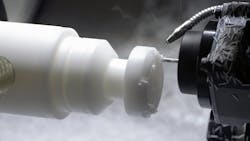You might know it as "PTFE”, but it also goes by several other names, including "polytetrafluoroethylene" and its brand name "Teflon." It is a plastic fluoropolymer that makes a vital contribution to numerous industries that touch our lives on a daily basis.
PTFE’s material characteristics are significant, and when you look closer at those characteristics you'll understand better why industries of all kinds can benefit from machining PTFE parts, while others apply it as a coating, and product designers select it for a variety of purposes and applications under a number of environmental conditions.
Manufacturers and fabricators can take on bulk quantities of PTFE as granules and powders in variable fineness — with the result being either mixed with another material, like glass, for added strength, or chemical modification for appropriation by any number of industries.
What makes PTFE parts stand out? — Flexibility is the primary advantage of PTFE, but it goes much further than that, too. PTFE parts also are electrically resistant, chemical-resistant, resistant to heat and, of course, non-stick. It's sturdy, holds up well even at high temperatures, and it resists amounts of water that would be trouble for other materials.
Additional advantages of PTFE as a building material include its:
• Virtually unrivaled resistance to chemical exposure;
• Strong resistance to temperature extremes and changes;
• Relatively high strength-to-weight ratio; and,
• High dielectric strength — or its ability to act as an electrical insulator across an impressive range of frequencies.
Some of the practical uses of PTFE out in the real world include:
• Coating walls and surfaces in residential or controlled environments, making these non-stick to repel insect and pest intrusions.
• In surgery, PTFE is used for tissue and organ grafts, as well as to inhibit infections from catheters and other medical equipment.
• Gore-Tex, the heavy-duty fabric that owes its success to PTFE, is used to make clothing materials, wiring insulation, medical implants and certain kinds of sealants, water-repellant or waterproof.
• "Dielectric strength" may not sound like a marquee feature, but this is the characteristic responsible for PTFE's continuing popularity in several computer and aerospace-related industries. In these and other fields, it lends its qualities as an insulator to the task of making electrical connections safe.
Aerospace part designers favor this material for other reasons too, as do those designing lightweight chassis and vehicle parts. PTFE is necessary for forming fiberglass and fiber composites, both of which are lightweight favorites, and it can be milled to achieve most common shapes and dimensions of machine component parts.
As far as applications where robust mechanical bearings and other parts are needed, PTFEs' closest competitors are nylon and acetyl — and PTFE outperforms both of them. Machined slide plates, mechanical gears and plain bearings from PTFE can be cost-effective over alternative material parts over a long run.
In the processing of foods and beverages, product handling surfaces often incorporate PTFE, to keep materials moving smoothly and hygienically.
Even further behind the scenes, you'll find PTFE doing unseen work in brake lines, hoses and oil pipelines, where it lends its frictionless quality to the movement of critical and often sensitive liquid fuels, coolants, and lubricants. In plumbing applications, PTFE and its derivatives can serve as a sealant in pipe threading and pipe joints in anything but the highest-pressure water systems.
Speaking of pipes, even musical instrument valve oils use PTFE to keep all the moving parts in good working order.
Tips for machining PTFE parts — Machining parts from PTFE does not differ significantly from manufacturing parts from other materials, with some minor exceptions:
• Unbalanced or bowl- or disc-shaped elements aren't a good fit for machining from PTFE.
• Some detailed projects, or parts with exceptionally tight tolerances, might require a different material.
• When placed under extreme pressure in specific environments where different materials meet, such as mechanical joints, PTFE can lose its shape. Consider the applications carefully, including the stresses placed on moving components.
• High-quality finishing options for plastics already are somewhat limited, compared with metals, but PTFE has an even lower tolerance to finishing.
PTFE on its own is a somewhat softer plastic than most others, but its unique properties make it useful, as we've seen, in a wide variety of industries and many conditions. What can it do for you?
Megan Nichols is an amateur astronomer and environmentalist, and a writer on a wide range of scientific topics. Recently on AmericanMachinist.com she offered 6 Reasons Your Shop Needs a 3D Printer and evaluated the significance of ISO 9001:2015 for Machine Shops. Follow Megan on Twitter @nicholsrmegan.
About the Author
Megan R. Nichols
STEM writer and blogger
Megan Nichols is a STEM writer and blogger covering a wide range of scientific topics at schooledbyscience.com
